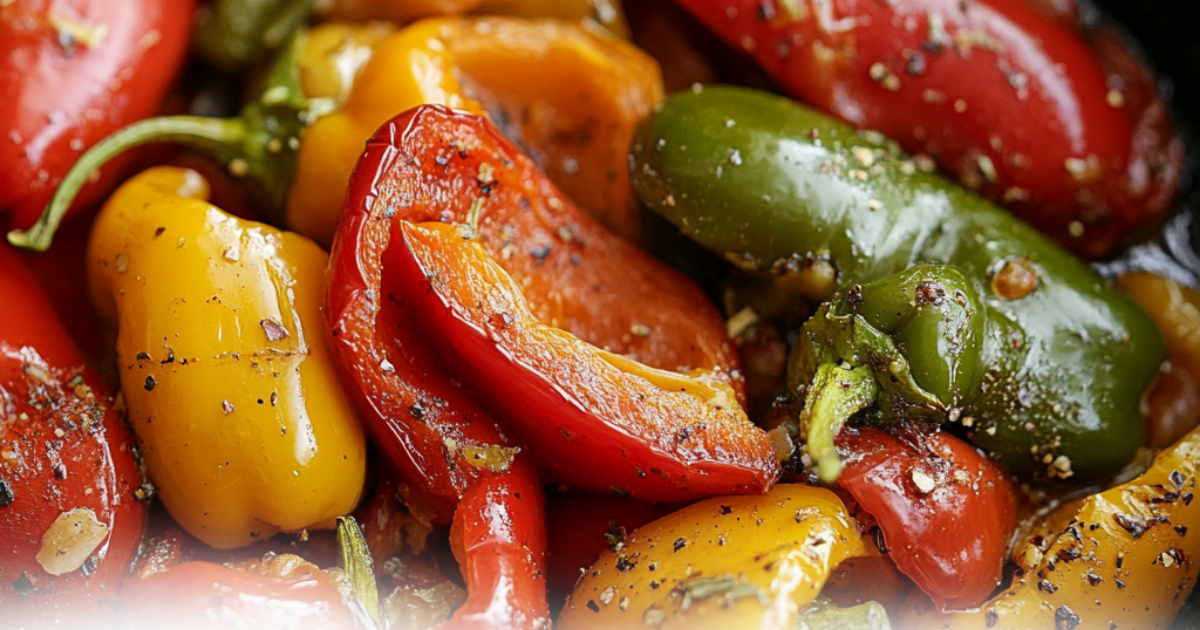Stuffed peppers are a beloved classic, celebrated for their versatility and comforting taste. But if you’ve ever tried your hand at making them, you may have wondered: Should I boil peppers before stuffing them? This seemingly small decision can have a big impact on texture, flavor, and cooking time.
In this article, we’ll dig into the pros and cons of boiling peppers, explore alternative preparation methods, and provide a step-by-step guide to perfect your recipe. Whether you’re a seasoned home cook or just starting out, this guide has everything you need to make the perfect stuffed peppers.
Table of contents
Introduction to Pre-Cooking Peppers
Why Ask, Should I Boil Peppers Before Stuffing Them?
When preparing stuffed peppers, one of the first questions you’ll encounter is whether to pre-cook the peppers. Boiling or parboiling softens the pepper’s texture, making it easier to cut through with a fork and bite into when served. While some cooks swear by this method for the tender results it provides, others prefer to skip it to retain the pepper’s natural crunch.

Boiling peppers isn’t just about texture; it also reduces the amount of time they need to bake in the oven. For busy cooks, this can be a game-changer, allowing you to speed up the cooking process without sacrificing quality.
Importance of Preparing Peppers Properly for Stuffing
Stuffed peppers have been around for centuries, appearing in cuisines worldwide, from Mediterranean dolma to American-style peppers stuffed with beef and rice. While the fillings often steal the spotlight, the way you prepare the pepper itself is just as important. Techniques like boiling, steaming, roasting, and even using raw peppers each create unique results.
Throughout this article, we’ll uncover why some methods work better for certain recipes and share expert tips to make sure your stuffed peppers turn out just right. Ready to find out if boiling is the right choice for your next meal? Keep reading!
Benefits of Boiling Peppers Before Stuffing
Does Boiling Improve Texture for Stuffed Peppers?
One key benefit of boiling peppers before stuffing them is achieving a softer texture. Boiled peppers are easier to cut through and chew, making them more enjoyable to eat. This step ensures the pepper is tender and complements the stuffing instead of being overly firm or chewy. Additionally, boiling peppers can reduce the likelihood of uneven cooking, especially when the filling contains ingredients that cook at different speeds.

For those wondering, should I boil peppers before stuffing them? the answer often depends on the desired texture. If you prefer a fork-tender pepper that melds beautifully with the filling, pre-cooking can make all the difference.
Can Boiling Peppers Reduce Cooking Time?
Another advantage of boiling peppers is how much it shortens overall cooking time. When you pre-cook the peppers, they spend less time in the oven because they’re already partially tenderized. This can be especially helpful when you’re using raw fillings that require extended baking. By reducing the time your dish is exposed to heat, you also minimize the risk of overcooking the filling.

If you’re tight on time, pre-cooking can be a lifesaver. Skipping this step might result in a crunchy pepper and undercooked filling, which is a common issue for beginners.
Why Boiling Makes Peppers Easier to Stuff
Boiling peppers before stuffing them also makes them easier to handle during preparation. Once boiled, the peppers become pliable, which means they’re less likely to crack or tear when you add your filling. This is particularly useful if you’re stuffing them with dense ingredients like meat or rice.
Furthermore, parboiling helps remove any lingering bitterness in the peppers. This makes the flavor profile milder and allows the stuffing to take center stage. Whether you’re preparing stuffed peppers for a family dinner or a party, this small step can make a big difference in presentation and taste.
Step-by-Step Guide to Boiling Peppers for Stuffing
Selecting the Right Type of Peppers for Stuffing
Before you decide, should I boil peppers before stuffing them?, it’s important to choose the right peppers. Bell peppers are the most popular choice due to their size and mild flavor. Red, yellow, and orange varieties offer a sweeter taste, while green peppers have a slightly bitter edge. For smaller portions or unique presentations, mini bell peppers are a fun option. Make sure your peppers are firm and free from blemishes for the best results.
Preparing Peppers for Boiling: Cleaning and Cutting
Start by thoroughly washing the peppers under cool water to remove dirt or debris. Next, slice off the tops to create a clean opening for stuffing. Remove the seeds and membranes inside to make room for your filling. If the peppers are unsteady, trim the bottom slightly to help them stand upright in the baking dish.
How Long to Boil Peppers Before Stuffing?
Timing is everything when boiling peppers. Bring a pot of water to a gentle boil and add the peppers, ensuring they are fully submerged. For the best texture, boil them for about 3-5 minutes. This process softens the peppers without making them overly mushy. Once done, remove them carefully and let them cool before adding your stuffing.
Tips for Retaining Flavor and Nutrients
To minimize nutrient loss, avoid boiling the peppers for too long. Using lightly salted water can enhance their natural flavor without overwhelming the dish. If you’re concerned about losing nutrients, consider saving the boiling water for soups or sauces. This way, you retain some of the vitamins and minerals that leach out during cooking.
Suggested Additional Recipe: For more kitchen inspiration, check out The Ultimate Guide to Crack Chicken Dip, which pairs wonderfully with stuffed pepper appetizers.
Cons of Boiling Peppers Before Stuffing
Does Boiling Cause Nutrient Loss in Peppers?
Although boiling peppers has its benefits, it can lead to some nutrient loss. Peppers are rich in vitamin C and other water-soluble vitamins, which can leach into the water during boiling. For those aiming to maximize the nutritional value of their stuffed peppers, this can be a concern. If you’ve asked yourself, should I boil peppers before stuffing them? it’s worth considering whether the slight reduction in nutrients outweighs the benefits of softer peppers.explore why peppers sometimes lose their structure when cooked
However, you can minimize nutrient loss by boiling the peppers for a shorter time or steaming them instead. Both methods preserve more vitamins while still tenderizing the peppers.
What Happens if You Over-Boil Peppers?
Overcooking is a common mistake when boiling peppers. If you leave them in the boiling water for too long, they can become overly soft and even mushy. This makes them harder to stuff and causes them to lose their structure during baking. For stuffed peppers to hold their shape and look appealing, they need to strike the perfect balance between tender and firm.
If you’re wondering, should I boil peppers before stuffing them, be sure to monitor the boiling process carefully. A quick blanch—rather than a full boil—is often enough to achieve the desired results.
Is Boiling an Extra Step You Can Skip?
Finally, boiling peppers adds an extra step to the cooking process. For some cooks, this can feel like an unnecessary complication, especially when you’re already preparing a filling and assembling the dish. If you’re short on time or prefer a simpler approach, you might find it easier to skip pre-cooking altogether.
Despite this drawback, many cooks find that the improved texture and flavor justify the extra effort. If you’re debating whether to boil your peppers, consider how much time you’re willing to dedicate to preparation and weigh it against the quality of the final dish.
Alternative Methods for Preparing Peppers
Steaming Peppers: A Healthier Alternative
For those who prefer a gentler approach, steaming is an excellent alternative to boiling. It softens the peppers while preserving more nutrients compared to boiling. Simply place the cleaned peppers in a steaming basket over boiling water, cover, and steam for 5-8 minutes. Steamed peppers hold their shape better and often have a brighter color, making them a great option for presentation.
Roasting Peppers for Added Flavor
Roasting is another popular method that enhances the peppers’ natural sweetness and adds a smoky depth. To roast, coat the peppers lightly with olive oil and bake them in a preheated oven at 375°F for about 10-15 minutes. This method is perfect for recipes that benefit from a caramelized, slightly charred flavor.
Using Raw Peppers Without Pre-Cooking
If you’re wondering, should I boil peppers before stuffing them, the answer might be no, depending on your taste. Using raw peppers results in a firmer texture and a fresher taste. This method works well for recipes with quick-cooking or pre-cooked fillings. Just be sure to bake the dish long enough to soften the peppers slightly while heating the filling thoroughly.
For more delicious ideas, consider exploring recipes like Delicious Tofu Fried Rice to complement your stuffed peppers.
FAQ Section
Do You Always Need to Boil Peppers Before Stuffing?
The short answer is no—you don’t always need to boil peppers before stuffing them. Whether you should boil peppers before stuffing them depends on the texture you want. Boiling softens the peppers, which works well if you prefer a tender bite or have a filling that needs less time to cook. However, if you enjoy a slight crunch or are short on time, skipping this step is perfectly fine. For baked dishes with longer cooking times, the peppers often soften enough without pre-cooking.
What Happens if You Skip Pre-Cooking?
If you skip pre-cooking, your stuffed peppers will have a firmer texture. This might be appealing if you enjoy a little bite in your peppers or are serving a dish with crisp, fresh ingredients. However, keep in mind that raw peppers can sometimes take longer to cook, which might affect your filling. Using raw peppers also means the flavors remain slightly more robust, adding a fresh contrast to the stuffing.
How Do You Prevent Peppers from Becoming Mushy?
The key to avoiding mushy peppers is to avoid over-boiling or overbaking them. When boiling, stick to 3-5 minutes, as longer times can cause the peppers to lose structure. During baking, check the dish regularly to prevent overcooking. Covering the peppers lightly with foil can also help control the cooking process by slowing down the softening.
Conclusion and Final Thoughts
Summary of Key Points
Deciding whether you should boil peppers before stuffing them comes down to personal preference and your recipe needs. Boiling helps soften the peppers, making them easier to eat and reducing oven time. However, it can also lead to nutrient loss and risks making the peppers overly soft if not done carefully. Alternatives like steaming or roasting can provide similar benefits with slight variations in flavor and texture.
Which Method Should You Choose?
If you want tender, easy-to-eat stuffed peppers and have a short baking time, boiling is a great choice. On the other hand, if you’re looking for more robust flavors or a firmer bite, consider roasting or using raw peppers. Ultimately, there’s no right or wrong answer—it’s all about what works best for your meal.
Explore More Recipes: For more tips and cooking ideas, check out the recipe article Perfect Shrimp Tacos with Slaw, which pairs well with your stuffed pepper creations.

